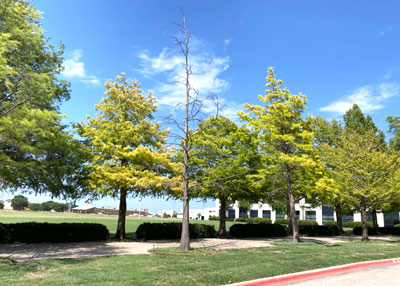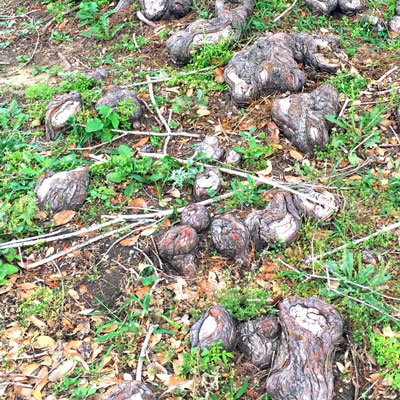Question of the Week – Number 2: July 8, 2021

“What is wrong with my bald cypress tree? Its needles are turning yellow.”
This is iron deficiency, otherwise known as “iron chlorosis,” or just “chlorosis.” Bald cypress trees, like dogwoods, East Texas pines, water oaks, azaleas, loropetalums, wisterias and gardenias, among many other plants, require high levels of soluble iron in order to thrive.
Unfortunately, iron becomes insoluble for uptake by our plants’ roots when the soil pH (acidity/alkalinity) climbs beyond neutral and into the alkaline range. While these plants are wonderfully suited to the acidic soils of East Texas, they often struggle when being planted along and west of the I-35 corridor.
Iron is part of the chlorophyll molecule, so when plants can’t take in adequate iron, there won’t be enough chlorophyll (the green leaf and stem pigment). That’s why leaves that are deficient in iron will be lighter green, yellow, or even white. Soon thereafter they begin to turn brown and die.
Iron deficiency will always show up first at the tips of the branches (on the newest leaves). Affected leaves will be yellowed with dark green veins. Gradually, as leaves turn more and more pale, entire branches will die and the plant will be lost.
With smaller shrubs such as gardenias and azaleas, it’s relatively easy to amend the planting soil to low pH levels prior to starting your plantings. That will work well for 5-10 years. And you can add supplemental iron and liquid sulfur soil acidifier to help keep the soil less alkaline. But eventually, if your local soils and irrigation water are highly alkaline (as in DFW, Austin and San Antonio and westward), you’ll probably have to dig the plants out and start the whole process over again.
With water oaks, pin oaks (often mistakenly planted for Shumard red oaks) and bald cypress the solution is much easier. You will just be creating a monster if you try to amend the soil for what will become a large tree’s giant root system. Plus, you would be adding many hundreds of dollars’ worth of iron and sulfur each year (probably with poor results). You need to cut your losses completely and remove and replace the tree with a better-adapted species.

And…
“What can I do about bald cypress roots that are sticking up out of the soil?”
Those are called “knees,” and they are breathing structures that bald cypress trees use to carry on normal root functions when they’re growing in swampy conditions. For whatever their reasons, a certain percentage of bald cypress trees develop these root structures even in upland settings.
Knees are not necessary to the health and survival of bald cypress trees in a landscape. They can be removed with a long-handled axe or cut flush with a chain saw. (Don’t let your chain saw blade make contact with soil, or it will be dulled instantly.) These knees exert a great amount of force when they push up on sidewalks, driveways, plumbing and other underground utilities.
For the above reasons, and for the fact that the mature size of bald cypress trees can top 50 or 60 feet (or more) tall and 40 or 50 feet wide, I warn homeowners to be sure they know what kind of a huge tree they’re actually buying before they plant one. They can turn into maintenance chores.
